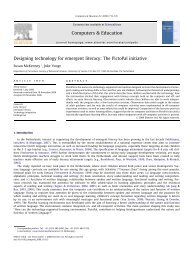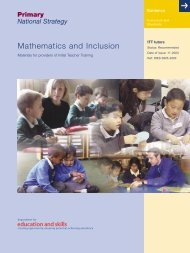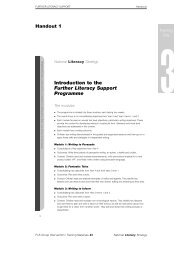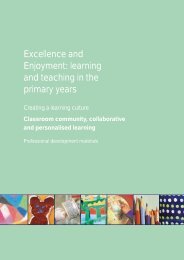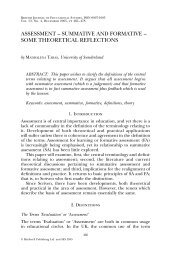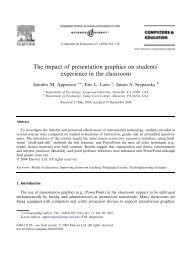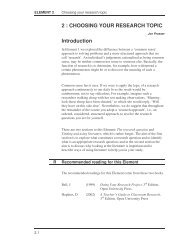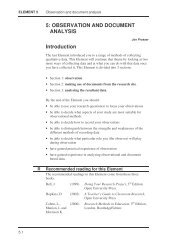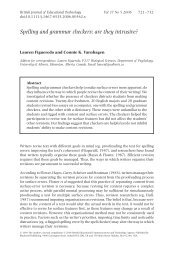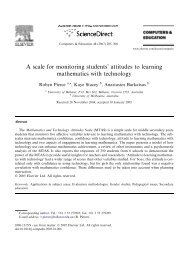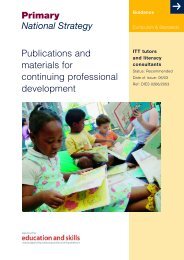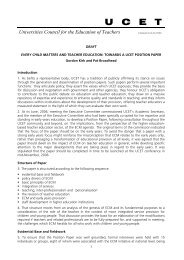jennys story , - PGCE
jennys story , - PGCE
jennys story , - PGCE
- No tags were found...
Create successful ePaper yourself
Turn your PDF publications into a flip-book with our unique Google optimized e-Paper software.
,<strong>jennys</strong> <strong>story</strong>an internet safety resourceA GUIDE TO USING JENNY’S STORYWelcome to Jenny’s Story – a resource pack which helpsyoung people understand the dangers of chatting to strangerson the Internet. This booklet is designed to help you makethe most of the Jenny’s Story teaching resource. It containsimportant information such as essential preparation and followup activities, as well as support materials, which should beviewed before showing the film to your students.
Ab o u t Ch i L d n e t in t e r n At i o n A LJenny’s Story has been produced by Childnet International, a charityestablished in 1995 with the aim to work with others in helping to make theinternet a great and safe place for children.Childnet has produced a range of support materials for teachers, parents andchildren. These include leaflets, lessons plans, interactive games, fact sheetsand presentations many of which can be downloaded from theChildnet website www.childnet.comChildnet is very keen to develop this resource and welcomes feedback fromteachers and young people. Please email info@childnet.com with yourcomments or suggestions.© Childnet International 2005 - 2007. All rights reserved.Childnet International Registered Charity No. 1080173Studio 14, Brockley Cross Business Centre,96, Endwell Road,London SE4 2PDTel 0207 639 6967Fax 0207 639 7027info@childnet.comYou can access this guide as a pdfdocument as well as the pre- andpost viewing questionnaires fromwww.childnet.com/jenny
Co n t e n t s1. About this guide 42. Background to Jenny’s Story 53. Preparing the lesson 64. The lesson plan 75. Discussion points 96. Follow up activities 117. Questions and answers 128. Strategies for getting out of difficult situations 149. Linking to the National Curriculum 1510. Handling disclosures 1611. Using ‘Jenny’s Story’ with parents 1812. Glossary of terms 1913. Technical requirements 19
1. Ab o u t t h i s Gu i d eJenny’s Story is a short film based on a true <strong>story</strong> of Jenny, a teenager whochats to a stranger on the Internet. The film shows how, through chattingonline, Jenny reveals personal information which results in her being contactedin real life and ultimately hurt. Jenny is not the real girl’s name.This guide has been written by Childnet to help those delivering Jenny’s Storyto get the most out of the session and equip young people with strategies toavoid, or get out of, difficult situations online.In this guide you will find the following:• Advice on how to prepare yourself to talk to young people about theirexperience with technology• A 50 minute lesson plan with guidance on where this subject can be bestbe taught within the curriculum• Pointers to support material such as pre-and post viewing questionnaires• Advice about follow up activities and running related activities such ascovering cyber bullying• Details of important agencies where you can report or get further advice.Who can use Jenny’s Story?Jenny’s Story was designed primarily to be delivered in the classroom bya trained teacher. It was specifically intended for KS3/secondary schoolstudents, although many teachers have suggested to us that some Year 6students may also benefit from seeing this film. Jenny’s Story can be used byother organisations working with or for young people 1 including:• Youth organisations• Training organisations• Companies wishing to train their staff• Police forces• Charities working with victims of abuse• Charities working with offenders• Children’s homes1 Because of the sensitive nature of the issues dealt with in Jenny’s Story we recommend that anyorganisation using the resource has a child protection policy.4
• Local authority social services departments• Adoption and fostering organisations• Libraries and study centres• Faith groups working with young peopleFor further information about ‘Jenny’s Story’ and electronic copies of thesupport information in this booklet, visit www.childnet.com/jenny2. Ba c k g r o u n d t o Je n n y’s St o r yChildnet began work on the Jenny’s Story film in 2003 to provide a resourcethat would bring the issue of Internet safety into teenagers’ real lives – tochallenge them and ultimately to change their risk-taking behaviour online, thuspreventing further cases of this type occurring. Childnet worked closely withan individual police force and launched Jenny’s Story in January 2005 with thehelp of the Home Office Minister Paul Goggins MP, the then Chair of the HomeSecretary’s Task Force on Child Protection on the Internet. Speaking at thelaunch Mr Goggins said,“I very much welcome the ‘Jenny’s Story’ film and the supportingmaterials produced for schools. This partnership is a great example ofhow different sectors can work together to create effective responses tothe child safety issues posed by the Internet. This is an appropriate anduseful teaching aid, which, in a very powerful way, raises the key issueswhich we need to get across in terms of child protection and child safetyon the Internet.”Childnet began looking for a case study, following in-depth research in focusgroups of young people (aged 12–16 years) in the UK and Denmark, whereyoung people told us that real stories told by their peers would have far moreimpact on them than any number of ‘awareness’ messages. We also assistedBECTA 2 in evaluating a US case study in UK schools. This revealed again thatcase studies prove a particularly effective way of having a more meaningfuldialogue with teenagers about Internet safety. Although cases of this type,where the perpetrator comes to the victim’s home, are extremely rare, it isnevertheless a reality that if young people give out personal details online tosomeone that they do not know, they could be putting themselves atserious risk. 32 British Educational Communications and Technology Agency see www.becta.org.uk3 49% of young people questioned say that they have given out personal information, such as theirfull name, age, email address, phone number, hobbies or name of their school, to someone that theymet on the Internet. By contrast, only 5% of parents think their child has given out such information.(Source: www.children-go-online.net)5
Leading up to the launch, Jenny’s Story was piloted and tested in a range ofsecondary schools, with 19 teachers and over 2000 students seeing the filmand completing pre- and post-viewing questionnaires. In total, 80% of thestudents who had viewed the film felt that it had significantly affected them andchallenged them to modify their online behaviour. Words that were used whendescribing the film were “honest”, “relevant” and “arresting”. All the teacherswho used the resource said they would recommend it to other teachers. Sincethen Childnet has continued to get very positive feedback from schools andother organisations about the impact of Jenny’s Story on young people.Since the publication of Jenny’s Story, a new national internet safety centre hasbeen launched in the UK called the Child Exploitation and Online ProtectionCentre (CEOP) where adults and children can report the suspected illegalactivity of online grooming to the police via a website www.ceop.gov.uk. Thisversion of Jenny’s Story has been updated to include reference to CEOP’sreporting website for young people which is called www.thinkuknow.co.uk3. Pr e pa r i n g t h e Le s s o nVery often after watching Jenny’s Story the first question that young peopleask is whether it is a true <strong>story</strong>. The answer will generally dictate howseriously they take the film. Jenny’s Story is a true <strong>story</strong> and has been toldusing the victim’s own words and is therefore very powerful. For this reasonwe highly recommend that you prepare yourself and the staff in your schoolor organisation for the variety of reactions that young people may have. Inparticular please read the ‘Handling Disclosures’ part of this document.The film itself is eight minutes long and the <strong>story</strong> has been told in a sensitiveand non-sensationalist way. To protect the victim, certain details have beenomitted. This may leave the young viewers with unanswered questions,and we have attempted to anticipate these in Chapter 7 of this booklet. Werecommend that you familiarise yourself with the answers before showing thefilm. It is important for young people to leave the session empowered with astrategy of what they would do or tell others to do in a similar situation.Informing YourselfSome teachers who use this film may not have used Instant Messenger orvisited a chatroom before. In preparation you might wish to visit Childnet’swww.chatdanger.com website, which will give you a good overview of howyoung people are ‘chatting’ using a range of interactive media, includingchatrooms, instant messaging, mobile phones and online games. Forstudents who are less aware, you may need to explain how chatrooms,instant messaging and online games allow users to link up with potentialstrangers. There is a glossary of useful terms at the back of this booklet. The6
Q&A section (on page 12) will help you answer some of the questions youngpeople may ask. It is at your discretion as a teacher to decide how much of thisbackground information you share with the class.Informing ParentsConsider whether it is appropriate for you to inform parents that students willbe looking at this topic. Depending on your school policy, it may be appropriateto send out a letter informing parents as well as giving the opportunity forthem to view the film themselves. This will reinforce the support you give tothe students and also help to educate their parents. The DVD has a shortintroduction aimed at parents. Childnet has produced other advice includingleaflets, a parents’ presentation and a new CD-ROM. These can be orderedfrom our website www.childnet.com. (Click on the ‘parent support’ link at thebottom of the Home Page). See Chapter 11 for using this resourcewith parents.Informing Child Welfare StaffThe film may raise some issues with students about abuse, or even highlightindividual cases of hassling or bullying online, so it would be advisable to talkto the school’s designated officer for child protection to discuss strategies forhandling disclosures and escalating issues. See Chapter 10 of this booklet,‘Handling Disclosures’.4. Th e Le s s o n Pl a nJenny’s Story has been designed for Key Stage 3 students. The ideas inthis plan are designed for a 50-minute lesson. A lesson using this materialwill connect with several objectives from the programmes of study in PHSE,Citizenship and ICT. For the exact references, see Chapter 9, Linking to theNational Curriculum.Lesson Objectives1.2.3.To help raise students’ awareness of potential risks, especially onlinegrooming, when using interactive Internet applications.To help students reflect on their own online behaviours.To inform students of the strategies they can employ to avoid getting intodifficulties online.7
Resources Needed• Jenny’s Story DVD• Pre and Post viewing questionnaire(download at www.childnet.com/jenny/resources.html).• Optional – A leaflet – Childnet’s ‘Keep SMART card’ for Secondary Schools– for each student to take away available to order atwww.childnet.com/order (see back cover)Lesson Outline: 50 minutesPart 1. Classroom discussion and pupil questionnaire – 10 minutesStart with a general discussion with the students about their experience ofchatrooms, email and computers.Ask them questions such as:• Who uses the internet at home?• Who uses it for chatting?• What do you use to chat to people online?• Do you chat to people you know in real life?• Do you chat to people you have never met?If you wish to assess the impact of Jenny’s Story you can use the pre and postviewing questionnaire at this point.Part 2. Viewing of Jenny’s Story DVD – 10 minutesIntroduce Jenny’s Story by telling the students that the DVD they are aboutto watch is based on a true <strong>story</strong>. Reassure them that if they have worries orconcerns following the session then they can talk to you or a trusted adult(see ‘Handling Disclosures’ for further information to prepare the children).The film tells the <strong>story</strong> of a 13-year-old girl who was sexually assaulted by aman she met on the Internet through chatting on Instant Messenger. The <strong>story</strong>is true and is told in the victim’s own words, but the part and voice in the filmare played by an actress.Part 3. Classroom discussion and replaying of sections of film –10 minutesOnce viewed, it is possible to replay sections of the film using the differentChapter headings from the main menu on the DVD. Discussion topics areavailable from the DVD menu. Further details are on the Jenny’s Story Q&Asection too.8
Part 4. Discussion on how to get out of difficult situations – 15 minutesTo follow the film, it is important to equip viewers with strategies on how toget out of similar situations online. Using the ‘Discussion Questions’ sectionaccessed from the DVD menu to help you, break the students into groups,no bigger than five, and give each group 2/3 of the questions to brainstorm.Give them five minutes to complete this task. Ask each group to report theirstrategies or advice for at least one of the questions.Part 5. Completion – 5 minutesIt is important to remind students at the end of the session that most childrenwho form online friendships with peers typically report a positive experience,and that there are wonderful, exciting ways of using the Internet positively(including for homework!). For examples of how young people have used theInternet to express themselves in positive ways, visit the Childnet Academywebsite www.childnetacademy.orgAssessment OpportunitiesIt is important to assess whether this film makes a difference, and how.Questions to review include:1.2.3.4.5.Would the students now give out personal details online to someone thatthey didn’t know?Would the students still meet up with someone they met online withouttelling anyone?If the students were concerned about anyone they had met online, wouldthey tell someone?Having watched Jenny’s Story, has it changed the students’ views aboutpassing an unknown person’s details onto a friend?Has it given the students strategies for how to get out of difficultsituations online?5. Di s c u s s i o n Po i n t sHere are some suggested discussion points which could be looked at whilereplaying the relevant section of the film. These points have been included onthe DVD itself so that you can display them on the screen after the film. Herebelow we include suggested answers or solutions, but the students may alsocome up with their own very valid solutions.9
1.2.3.4.5.6.How could Jenny be made to do things that she wouldn’t normally do?Discuss the difference between talking to people online and talking to themin real life, i.e. people are generally less inhibited online because of theanonymity. Ask the students to think about things that they might do onlinewhich they wouldn’t do offline.Why did Claire pass Jodie on to Jenny?Claire wanted to get rid of Jodie and didn’t know how to do this withoutbeing embarrassed or feeling that she was offending her. Have youngpeople in your group ever passed on details of a stranger to someoneelse? Do they know how to block a user on Instant Messenger? Do theyhave strategies to tell people they no longer want to talk to them?Why did Jenny feel pressurised to give out her address?When Jodie asked for Jenny’s address, Jenny had no answer to whyshe shouldn’t give it out. So when Jodie asked ‘Why not?’, Jenny feltpressurised. Also, Jodie tricked her into believing that she could get itanyway. Discuss with students what answer they can give to people askingfor personal information, e.g. ‘Why do you want to know?’Jodie got Jenny to reveal a lot of personal information, including whenher parents would be out. What other subjects might you discussonline which could give away vital information without you realising it?E.g. football team, other things which give away your geographicallocation, like the school you go to. It is also important to discuss what ismeant by ‘personal information’, and why things that children might notconsider as personal shouldn’t be shared, for example their email addressor Instant Messenger ID.What do you think made Jenny trust Jodie?Because she thought that she was a woman? Because she told her shecould be a model?At what point could Jenny have told someone about Jodie?For example:(1) The first time she suspected that Jodie was asking too many questions?(2) After she had given out her address?(3) After Jodie’s boss called?It is important to stress that students need to be suspicious the first timethey feel uncomfortable, rather than waiting until a relationship has beenestablished. Young people can be more easily manipulated and find itharder to get out of a conversation once a relationship is established.7.Who could Jenny have told?Discuss with students who they could trust and whether it is a good idea totalk only to their friends when they are really worried about something.10
8.What stopped Jenny from telling anyone about what had happened?She was blackmailed with the webcam pictures and made to feel ashamedand afraid and that it was her fault. (It is worth telling the students that afterthe event, Jenny’s greatest wish was that she had told someone sooner.)6. Fo l l o w Up ActivitiesAfter the session you may wish to give each student a copy of Childnet’sKeep SMART card, which contains advice about mobile phones and using theInternet safely. The leaflets point to other resources and links to wider sourcesof help and advice. (More copies are available to order from Childnet websitewww.childnet.com – click on ORDER).Childnet has also produced a set of CD-ROM resources for students andparents, called ‘Know IT All‘. This covers other areas of Internet safety, such ashow to evaluate websites and mobile phones safety.See www.childnet.com/kiaChildnet’s Chatdanger website www.chatdanger.com contains lots of otherpersonal stories and advice. There is also a contact form on the website ifchildren have specialist questions they would like to ask Childnet staff.Further extension activities can involve encouraging your students to completethe quiz in www.websafecrackers.com. Look at the ‘Blah Blah Blah’ sectionin particular.Running sessions for boysSince Jenny’s Story is focused on a teenage girl, some boys may be convincedthat this would never happen to them. This is obviously a good opportunityfor a lively discussion. However, if you want to run another session about thedangers to boys, CEOP have produced a number of films which use scenariosinvolving boys as well as girls, see www.thinkuknow.co.ukA practical demonstrationIt may be helpful to have a live conversation using an Instant Messengerapplication with all students. You will need to set up a projector and a liveinternet connection. This conversation would be between a girl, boy and ateacher from the class using disguised usernames who are situated in anotherroom. The students in the class then have to guess who is communicatingwith who by observing the conversation on the whiteboard or screen. Thisdemonstrates how difficult it is to tell the real identity of a person online.11
Discussing Cyber bullyingWhilst Jenny’s Story is generally used to address the issue of internetgrooming, it is also very useful in talking about cyberbullying. According torecent research by the UK Children Go Online project, bullying through theinternet or mobile phone is on the increase, and as many as 33% of childrenhave experienced it in some form or other. See www.children-go-online.netJenny’s Story illustrates some important points about cyber bullying, forexample the way that the perpetrator harasses Jenny for her personal details,and how he uses an image of her to blackmail her. Check Childnet’s websitefor further advice and guidance about cyber bullying.7. Qu e s t i o n s a n d An s w e r sHere are the answers to some questions that students may ask. It is importantthat you answer their questions after viewing the film and ensure that anyconcerns or misunderstandings are clarified.1.2.3.4.5.6.How old was Jenny when this event happened?Jenny was 13 years old when this happened.When did this event take place?This happened in 2003.How did Jenny meet Jodie?Jodie got passed on to Jenny by her friend Claire on Instant Messenger,because Claire thought that Jodie was acting “weirdly”.Why did Jenny’s friend pass on someone who she thought was weird?Claire passed Jodie on to Jenny because she didn’t have a strategy to getrid of a person who she thought was acting strangely. She didn’t feel ableto tell Jodie to go away herself, or to block her.Why did Jenny take her top off for the webcam?Jenny took her top off because she thought that Jodie was a trustworthywoman, and she really wanted to be a model. She was in the privacy ofher bedroom when she did it, which made her feel as though no one elsewould see the image of her. She also didn’t know how to say ‘No’ withoutseeming to not trust Jodie.What is an IP address?An IP address is the Internet address of your computer. Every computerconnected to the Internet has one. The IP address doesn’t tell anyonewhere a computer is physically located.12
7. Can anyone trace your home address from your IP address?No, this information is held by Internet service providers and is onlyaccessible to themselves and also the police in the case of criminal activity.It is important to stress that people cannot generally locate you by usingIP addresses.8. What actually happened to Jenny?Jenny was sexually assaulted; the perpetrator came to her home andpushed his way in. The man also took several indecent photographs of her.She was not raped.9. How many times did the man come round to Jenny’s house?Only once.10. Why did Jenny not tell anyone?Jenny was made to feel ashamed of what she had done on the webcam.The man threatened that if she told anyone he would publish the imagesonline and her family would see them. Jenny felt that things had gone toofar for her to be able to stop them and that she would be blamed. She alsothought she would get into trouble and that no one would believe her.11. How did the police track the criminal?The offender targeted other young female victims, although Jenny wasthe only one who was visited at her home address. The police caughtthe offender after investigating these other offences. They seized andexamined his computer, where they found the contact details of Jenny.12. How old was the criminal?The criminal was 50 years old.13. What happened to the criminal?He was caught and convicted and received a substantial term ofimprisonment.14. Did Jenny contact the police?No. Jenny did not contact the police; they contacted her when they foundher contact details on the criminal’s computer. The police got in touch withher, and treated her with great care and sensitivity.15. Does this happen to lots of people?Compared to other crimes, incidents of this kind of Internet-related crimeare low. As far as we know a case of this sort, where the criminal comesround to a person’s house, is extremely rare.16. How is Jenny now?Jenny is doing fine. She still enjoys using the Internet but is much morecautious about giving out personal information.13
8. St r at e g i e s f o r Ge t t i n g o u t o f Dif f ic u lt Si t uat i o n sIt is important to equip young people with strategies for getting out of difficultsituations, particularly grooming situations online, and to leave them feelingempowered after the session. See the glossary for a definition of‘Online grooming’Introduce this session by asking students what Claire’s strategy was for gettingout of talking to Jodie. Is this an effective and safe strategy?Explain and discuss these suggested strategies with your students:1.2.3.4.5.6.If you feel uncomfortable about what someone is saying, you can just quitor log out of the conversation – and if possible, block that person or reportthem to the chatroom provider abuse team. A good chatroom providershould always make it clear how to report abuse.You can tell the other person that you are saving the conversations, whichmay put a predator off. If you are being abused, bullied or harassed byanyone online, you should always save conversations as evidence. (Formore information on how to do this, see the ‘Blah Blah Blah’ section ofwww.websafecrackers.com)You can refuse to answer questions of a personal nature, A predator mayask for a photo but refuse to send one of their own (though still beware, asthey might use a fake one). Childnet recommends that you never send aphoto of yourself to someone you don’t know offline.If the person is harassing you, it is important to know that this is againstthe law, and that you have the right to report that person. The police havethe power to contact the chat providers and find out more about theabuser.If the person is being persistent but not harassing, like in Jenny’s casewhen he kept asking “Why?”, it is important to question why someonewould want this information. Remember you don’t have to answer. Don’t beafraid to say ‘No!’.If the person chatting to you mentions information about your location,or makes you feel afraid, then you should take a copy of the savedconversation to a parent or guardian so they can report it to the police.In the UK you can report this online to the Child Exploitation and OnlineProtection Centre, see: www.ceop.gov.uk, or for young people seewww.thinkuknow.co.uk. If you are outside the UK, you can reportvia www.virtualglobaltaskforce.com and they will direct you to theappropriate agency in your country.14
As teacher it is important for you to stress to the group that for an adult toengage with a minor on the Internet with the intention of having a sexualrelationship is now illegal because of the ‘grooming’ clause in the SexualOffences Act 2003. Ask them, does knowing that it is illegal make it seemeasier to report these kinds of incidents to a trusted adult or the police?9. Li n k i ng t o t h e Nat i o na l Cu r r ic u l u mKey Stage 3 ICT Programme of StudyGeneral area ofknowledge, skill orunderstandingExchanging andsharing informationReviewing,modifying andevaluating work asit progressesSpecific teachingpoint from theprogramme of study3(c) How to useICT, includingemail, to share andexchange informationeffectively.4(d) Pupils shouldbe taught to beindependent anddiscriminating whenusing ICT.Relevance to Internet safetyPupils can be alerted to the safetyissues of using email, chatrooms, instantmessaging and other forms of “directcontact communication”, and taught howto communicate safely.Pupils should be encouraged to take acommon sense approach to using theInternet and related technologies, knowingthe appropriate behaviours that they (andothers) should adopt online, along withappropriate strategies if things go wrong.Key Stage 3 Citizenship Programme of StudyGeneral area ofknowledge, skill orunderstandingKnowledge andunderstandingabout becominginformed citizensDeveloping skills ofparticipation andresponsible actionSpecific teachingpoint from theprogramme of study1(a) Pupils should betaught about the legaland human rightsand responsibilitiesunderpinning society,and how both relate toyoung people.3(c) Pupils shouldbe taught to reflecton the process ofparticipating.Relevance to Internet safetyPupils should be taught about their rightsto privacy and how they should protectthe privacy of others by not disclosinginformation when using the Internet.There is opportunity to discuss theissues relating to communicating usingICT. The safety issues of using email,chatrooms, instant messaging and textmessaging can be discussed, alongsidethe problem of cyber bullying, which isoften associated with these forms oftechnology.15
Key Stage 3 PHSE Programme of StudyGeneral area ofknowledge, skill orunderstandingDeveloping ahealthy, saferlifestyleReviewing,modifying andevaluating work asit progressesSpecific teaching point fromthe programme of study2(f) Pupils should be taughtto recognise and manage riskand make safer choices.2(g) Pupils should be taught torecognise when pressure fromothers threatens their personalsafety and wellbeing and todevelop effective ways ofresisting pressures, includingknowing when and where toget help.3(a) Pupils should be taughtabout the effects of all typesof stereotyping, prejudice,bullying, racism anddiscrimination, and how tochallenge them assertively.3(j) Pupils should learn toresist pressure to do wrong,and to recognise when othersneed help and how to supportthem.Relevance to Internet safetyPupils should be taught how tominimise risks to their personalsafety when using ICT.Pupils should have strategies forgetting out of difficult situationsonline, and should also knowwhere to go for help and have theconfidence to reach out to get it.This is a good area to introduceissues relating to cyber bullying,such as by mobile phone or inchatrooms.This is a good way in to discussresponsible use of the Internetin relation to friends and otherpeople who young people mightput at risk through their behaviouronline.10. Ha n d l i ng Di s c l o s u r e sAs a result of discussions held on these issues, some students may discloseincidents of abuse. These may be about abuse to themselves or to someonethey know. Here are some courses of action you may wish to consider:1.2.3.4.If this disclosure happens in the school setting, it is important not topromise confidentiality to the child. Explain to the child what you are goingto do with the information and why.Your first point of contact following disclosure by a child should be thedesignated child protection officer within the school or organisation.Remember to write down exactly what the child has disclosed, as soon aspossible.The child who has disclosed is likely to feel worried, distressed orfrightened, and that the process is out of their control. They need to feelinvolved and you should offer them the opportunity of being alongside youwhen you report to the designated officer in the school.16
ReportingIf a pupil believes that he/she is being groomed by an adult on the Internet orreports that he/she has met offline an adult he/she initially met online, thenthis should be reported to the Child Exploitation and Online Protection Centre(CEOP) via their website at www.ceop.gov.uk. It would be advisable for thestudent to show the evidence of their communications with the person inquestion by copying conversations and by keeping emails and text messages asevidence. However, these cases can be investigated with minimal evidence.Being informed of potentially dangerous situationsMany victims of crimes of this nature choose not to disclose it to adults but maytell a friend. There may be a number of reasons for this, not least the fear thatthe others may not believe them, or that rather than being listened to, they willget into trouble. The police have specialised units for dealing with victims, andstudents should be reassured that victims are treated with care and sensitivity,and should not be discouraged from reporting should they find themselves in asimilar situation.CEOP have set up a special website called www.thinkuknow.co.uk, wherestudents can report instances of grooming or abuse. It is important to explainthe consequences of reporting to CEOP to the young person. Let them knowthat all reports to CEOP are taken seriously and that CEOP will be in touch andmay send officers to the young persons home or school.If a pupil discloses that they or one of their friends is planning to attend ameeting with someone that they have met on the Internet without a parent orguardian, the parent/guardian should be contacted and advised of this situation.The teacher may also contact CEOP – or at least advising the parent/guardian totake this step – if he/she has reason to believe that the pupil’s safety is at risk.Remind young people that they can also call ChildLine to talk inconfidence, on 0800 1111. For child help lines in other countries seewww.childhelplineinternational.org.Children creating and distributing harmful or illegal contentAs part of the Jenny’s Story teaching session it is important to look at the issueof children themselves creating harmful or illegal content. Many young peopleare naturally inquisitive and may want to test the boundaries of behaviour online.They may go beyond acceptable boundaries without realising the implicationsof their actions, and may inadvertently create harmful and even illegal materialwhich they can circulate by mobile phone or put on a website. This will need tobe dealt with immediately by the school. It is also important to let young peopleknow where the legal boundaries are, and that they could get into trouble withthe law for creating or circulating such material. Illegal material can include17
indecent or abusive images of children (sometimes called child pornography),images featuring extreme acts of sexual activity such as bestiality, nonconsensualsex, extreme torture and racist writing. Even material which may notbe illegal can cause extreme distress, (eg the recording of a prank on a mobilephone) and young people need to be aware of how others may be hurt by whatthey do, whether they intended it or not. School bullying policies need to beupdated to include reference to cyber bullying.If a child reports having seen illegal material on the Internet, or that someonehas sent them this material, then a report should be made to the Internet WatchFoundation (www.iwf.org.uk). For hotlines in other countries seewww.inhope.org. You could also consider contacting the local police.If a child has been seriously upset or disturbed by anything that they have seenor that has been said to them on the Internet or by mobile phone, you can referthem to the school’s pastoral care system and alert a parent/guardian. You canalso recommend that they talk to ChildLine in confidence on 0800 11 11.11. Us i ng Je n n y’s St o r y w i t h Pa r e n t sDuring the evaluation of Jenny’s Story, many teachers suggested that thefilm be shown to parents. Whilst we would encourage schools to engageparents on this issue, it is important to bear in mind that Jenny’s Story hasbeen created for teenagers who may feel that they know more than adults yettend to underestimate the risks. Parents, on the other hand, can sometimesoverreact. It is difficult to achieve a balance – of raising awareness of the issuesand empowering parents so that they feel able to engage with their children’suse of technology, while not worrying them so much that they simply ban orblock it. This may be counterproductive, not just by stopping positive uses oftechnology, but because young people can be adept at finding ways of gettinground bans, for example by logging on at school, at internet cafés or at thehouses of friends whose parents may not be aware of the risks. If they then getinto difficulties, it will be even harder for them to admit what has happened andask for help.Childnet’s view about Internet safety is therefore to encourage dialoguebetween parents and children rather than taking a more restrictive approach.So it is important to accompany Jenny’s Story with practical advice for parents.The DVD helps with this and in the section on the DVD for parents there is a clipof Childnet’s Chief Executive addressing parents. When arranging a showingof Jenny’s Story for parents, you may wish to begin with this clip. AlternativelyChildnet have recently developed a CDROM for parents called Know It All, thiscan be used for presentations to parents, and can be viewed online atwww.childnet.com/kia18
12. Gl o s s a ry o f Te r m sBelow are some definitions of terms used in this guide.• Chatroom – A special place on the internet where you can chat to one ormore people.• IM (Instant Messenger) – Technology similar to that of chatrooms, whichnotifies a user when a friend is online, allowing them to ‘converse’ byexchanging text messages.• IP (Internet Protocol) address – Every computer connected to the Internetis assigned a unique number known as an Internet Protocol (IP) address.Since these numbers are usually assigned in country-based blocks, an IPaddress can often be used to identify the country from which a computer isconnecting to the Internet. It is not possible to tell the exact address of anindividual using the IP address.• Online grooming – Online grooming is defined by the UK Government as:“A course of conduct enacted by a suspected paedophile, which wouldgive a reasonable person cause for concern that any meeting with a childarising from the conduct would be for unlawful purposes.”• Webcam – A digital camera designed to take photographs and transmitthem over the Internet.For further definitions of terms, see the glossary of the Know IT All for ParentsCD ROM at www.childnet.com/kia13. Te c h n ic a l Re q u i r e m e n t sTo view the film, simply enter the disk into a DVD player. Alternatively youcan use the disk in a PC if it has a DVD disk drive and software for playingDVDs. You will need speakers for the sound. The resources on the DVD can beaccessed from the main menu. Just follow the onscreen instructions.If you have problems viewing the DVD you can contact Childnet on020 7639 6967.You can access this guide as a pdf document fromwww.childnet.com/jenny19
Childnet has produced a special leaflet for young people reminding them of key internetand mobile phone safety tips. This can be ordered at www.childnet.com/orderSee the following Childnet websites for more information and advice on how young peoplecan use the internet positively and safely.www.kidsmart.org.uk www.chatdanger.comwww.childnet.com/sorted



